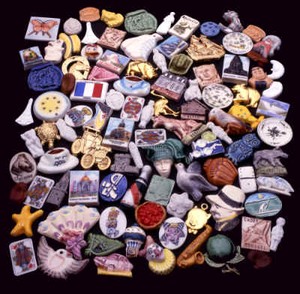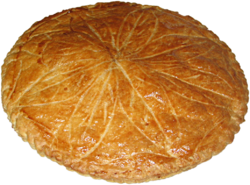La Galette des Rois, Twelfth Night Cake

- SUBSCRIBE
- ALREADY SUBSCRIBED?
BECOME A BONJOUR PARIS MEMBER
Gain full access to our collection of over 5,000 articles and bring the City of Light into your life. Just 60 USD per year.
Find out why you should become a member here.
Sign in
Fill in your credentials below.
A galette des rois and its crown
Bring on the Kings
Whether “Parisian style”, a light and flaky puff pastry pie, plain or filled with frangipane almond paste, or the Provencial orange flavoured brioche cake adorned with candied fruit, the Twelfth Night Cake and its crown is an essential part of the holiday tradition in France. Intended to celebrate the week of January 6th or Epiphany, a date marking the visit of the three Kings to the manger, the word itself betrays its pagan origins.

Twelfth Night according to Jacob Jordaens, The King Drinks (c.1640)
Round and as golden as a sun, like those sumptuous tangerines that garnish French tables all winter long, the galette remains a reminder that December 22nd is the longest night of the year, but also the beginning of a new solar cycle. In ancient Greece, the word already meant “ to appear”. The Ephanes were divinities such as Zeus, Athena, Hermes or Poseidon who made periodical “appearances”among the Greeks. It is no surprise that Three Kings’ Day is so popular in Europe, the Sea King, Poseidon, was so highly celebrated that, in some parts of ancient Greece, Winter Solstice festivities in his name lasted two full months!
The Romans carried on the Greek tradition by honoring the deity Saturn. Their seven day Winter Solstice festivities, known as Saturnales, were something like today’s Carneval, where masters became slaves and slaves became masters. The person who found the feve in his piece of cake was crowned and his wishes were granted throughout the day. If early Christianity borrowed the word Epiphany to mean the earthly “appearance” of the Christ Child to the three Kings, the term “Jour du Roi”, or King’s day, only dates back to the early 19th century.

A Southern Alps traditional orange flavoured brioche
From beans to bone china
Still called a “feve”, today a small porcelain or plastic figure, just large enough to avoid being swallowed, has replaced the orignal “feve” or kidney bean. The Twelfth Night cake is cut up into as many slices as persons present and a slice is distributed to each on of the invited guests. Though tradition has it that the youngest participant be invited to crawl beneith the table and distribute the slices, this is rarely put into practice today.
Since King’s Day is not a national holiday in either France or Belgium, it is usually celebrated on the 1st Sunday of January, provided that Sunday doesn’t fall on a January 1st. Note that the tradition is just as often found in the workplace and that another present day addition to tradition generally expects that the person who finds the feve will furnish another galette the following week. Fortunately the obligation to replace the galette doesn’t go beyond that second week or France would be celebrating Twelfth Night all year round!
_small.jpg)
An original “feve” and four present day “feves”
Should you be lucky enough to be traveling through Brittany any time soon, you might want to stop by a museum located in the town of Blain, 39 km northwest of Nantes. Blain’s former town hall houses a collection of “feves” estimated to be anywhere between 10,000 and 20,000 in number. In addition to reproducing scenes of professions from the past, this little known arts and crafts museum is also home to various gallo-roman artifacts and to a collection of over fifty manger scenes gathered together from around the world.

A few examples of Blain’s collection of over 10,000 feves
And as a little French New Year’s 2014 gift, or “étrenne”for one and all, you will find a recipe for Parisian Galette des Rois here. Don’t worry, you won’t have to struggle to understand how to make it. The video is also a mini French lesson in both French and English.

Parisian galette des rois, northern France
Sources:
Photos:
More in cooking at home


